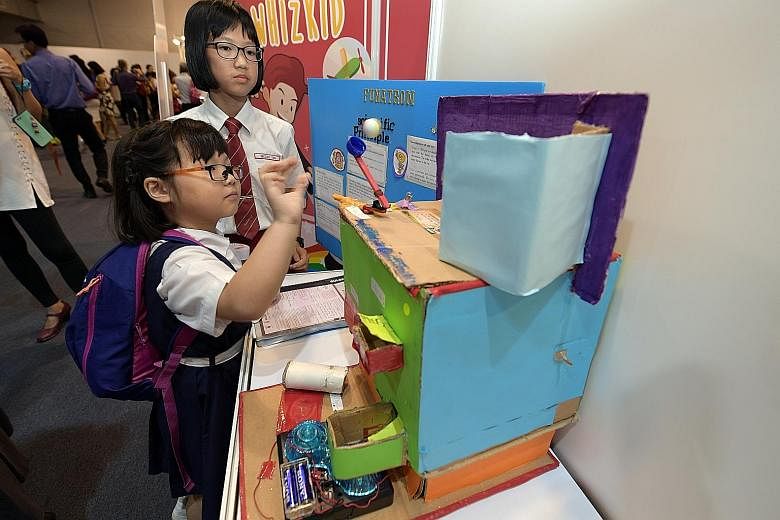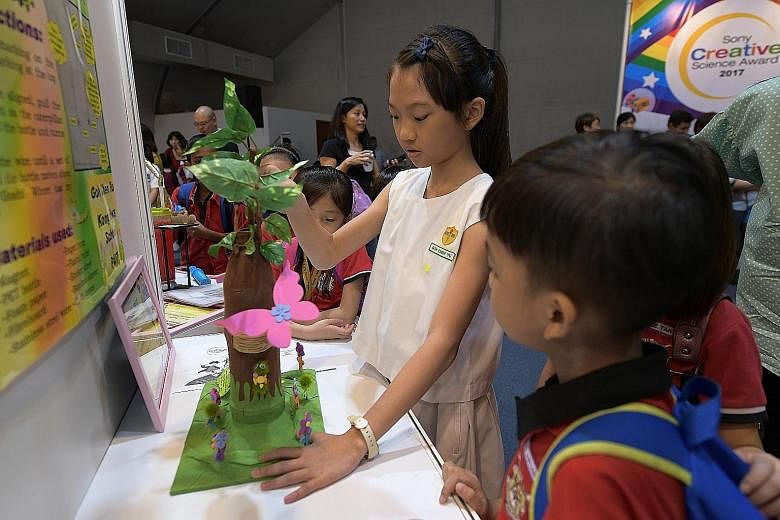When trying to come up with a concept for a science project, 11-year- olds Nicole Tan and Rachel Toh looked to one of their favourite video games for inspiration: Angry Birds.
Noticing that the game was a good example of kinetic energy and physics at work, they devised a toy that would demonstrate energy using ping-pong balls to approximate the grumpy fowl. Using catapults, players would shoot the balls at targets and this would trigger a chain reaction of lights and sounds.
The toy - which Nicole and Rachel named "Funatron" - won first place in the Whizkid category at the Sony Creative Science Award (SCSA) last Thursday.
Nicole said: "We were playing Angry Birds on this (arcade) machine, but it didn't dispense anything, so we had an idea to improve on this and make a toy where you have to earn things to get a prize."
This year marks the 20th edition of the toy-making competition, jointly organised by the Science Centre Singapore and the Sony Group of Companies in Singapore, and supported by the Ministry of Education. SCSA is the largest toy competition in Singapore for primary school pupils and encourages toy inventions that utilise science, technology, engineering and mathematics principles.
Minister for Education (Schools) Ng Chee Meng, the guest of honour at the event, said: "It is refreshing to see the creative talents of young children surface for us to enjoy. Through these children, we see the bright future of Singapore."
He also stressed the importance of learning beyond the classroom.
"Foundational learning in our school system today is a good launch pad, but is insufficient. Applied learning is a good tool to energise our pupils' creative energies so they can meet the challenges of an uncertain world ahead," he said, urging pupils to continue using their imagination.
"Go chase your rainbows," he added.
This year, SCSA received 4,300 entries from 99 schools, more than twice the number of entries received when the competition started in 1998.
Science Centre Singapore chief executive Lim Tit Meng told The Straits Times that over the years, there has not only been an increase in the number of entries but also an increase in the variety, concept and ideas of the entries.
He highlighted the importance of focusing on primary school pupils.
"All kids are born wanting to inquire, investigate and innovate. Primary school pupils still have that in them and we want to encourage and nurture this," he said.
Other winners at the awards were 10-year-olds Goh Chen Yu and Yap Leia, and eight-year-old Yap Jyan.
The Yap siblings' invention was a lava lamp-like device, called "Mix Me If You Can", that demonstrates the effects of mixing different elements, while Chen Yu made a magnetic model that turns caterpillars into butterflies, called "Where Has My Caterpillar Gone?"
"I've always loved playing with toys and magnets. My favourite magnets are button magnets, which I used in this toy," said Chen Yu.
The top three winners of the Whizkid and Scizkid categories will go on a sponsored trip to Japan to visit educational facilities and attend a workshop with Japanese pupils.
Said Rachel: "This whole process has been very satisfying.
"In the future, I want to contribute to society through creative thinking."


